That's a secret, private world you're looking into out there.
People do a lot of things in private they couldn't possibly explain in public.
Detective Doyle in the movie Rear Windows (1954) by Alfred Hitchcock (1899-1980)
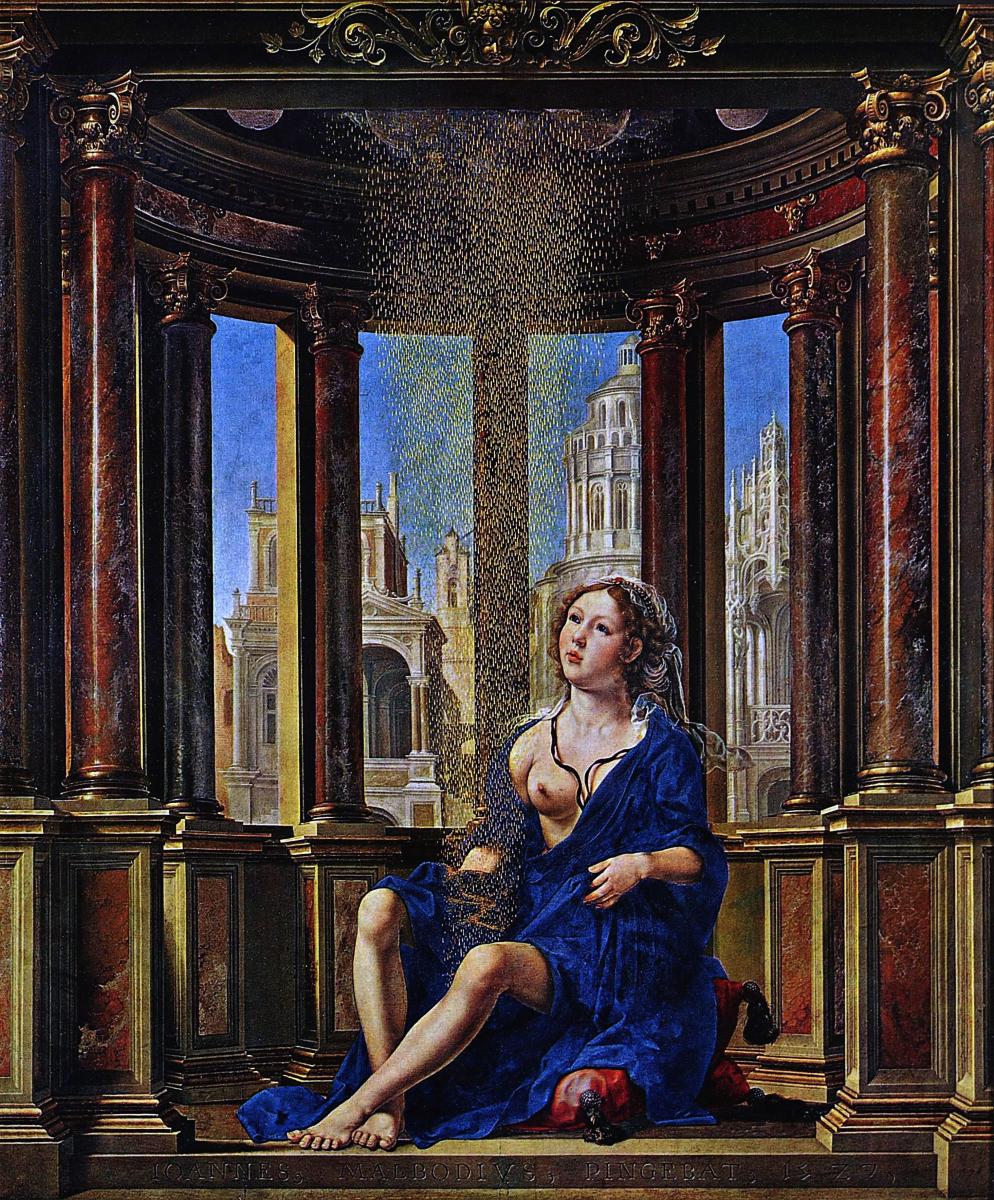
1 | Jan Gossaert van Mabuse, Danaë, 1527, oil on oak panel, München, Bayerische Staatsgemäldesammlungen, Alte Pinakothek.
This article is dedicated to the afterlife of the Danaë myth with special focus on the painting (1527) by Jan Gossaert van Mabuse (1478-1532), from the Bayerische Staatsgemäldesammlungen of Munich Alte Pinakothek, signed on the stairs below Danaë's feet as: JOHANNES MALBODIUS PINGEBAT 1527 [Fig. 1].
The story of Danaë was a frame story for the Perseus myth (Kahr 1978, 43-55; Lissarrague 1996, 105-133). Danaë, Perseus' mother, was locked away in an impenetrable tower of bronze (or in some versions of the story, iron) by her father Acrisius, king of the Greek city-state Argos: an oracle had warned Acrisius that he would one day be killed by his grandson. As a precaution, the king locked up his only daughter, planning to keep her there until she was too old to have children. But Zeus had become interested in the beautiful virginal Danaë, and penetrated the tower in the form of a golden shower of dust through the opening (in other versions, through a grate) in the upper vault of the tower – the classic oculus (Sanjania 2010, 10) – and impregnated her womb. Danaë gave birth to Perseus. Acrisius, still fearing the oracle's prediction, had mother and child locked into a wooden chest, and cast them into the sea. They eventually washed ashore on the island of Seriphos, where a friendly fisherman named Dictys took them in and cared for them. When Perseus grew up, Danaë told him the truth about his birth and his childhood.

2 | Antonio da Correggio, Danaë, 1531, oil on canvas, Rome, Galleria Borghese.
The Danaë by Jan Gossaert is one of the earliest Renaissance interpretations of the myth, and precedes more famous versions by Correggio (1489-1534) [Fig. 2], Titian (1490-1567) and Tintoretto (1518-1594). Gossaert’s Danaë was presumably painted for Philip of Burgundy (1464-1524), admiral of the Burgundian-Habsburg fleet, Bishop of Utrecht and Lord of Utrecht from 1517 onwards (Sluijter 1999, 10). He died in 1524, several years before the painting was finished. Gossaert’s interpretation of the myth was underappreciated for a long time (Corboz 2000, 9-29). In 1923, Achille Ségard (1872-1936) described the Danaë as a mindless woman, incapable of thought, whose only job was to sit still and look pretty for the nude genre (Segard 1923, 49). Max Friedländer (1876-1958) considered Gossaert's painting as unbalanced when it came to quality (Friedländer 1930, 33). In the 1965 exhibition in Rotterdam, the work isn't even mentioned (Pauwels, Hoetink & Herzog 1965, passim). Robert Wolf and Roland Millen are the harshest with their criticism. According to the authors, this Danaë is a peasant girl in disguise, a farmer amidst a mess of architectural elements, painted by a man who was lost in his own urban memories (Wolf, Millen 1968, 174). Only Wolf-Dieter Dube’s book on the collection of the Alte Pinakothek of München (English version 1974) shows an appreciation for the complex architecture in the background, which shows a lot of expertise on late-Gothic and Renaissance architecture across Mediterranean and North-European borders (Dube 1974, 122-124). Dube notices that due to the lack of landscape, Danaë is depicted as crushingly lonely. The painting is literally bursting at the seams, which combats the sensual meaning of the mythological subject.
.jpg)
3 | Franciscus de Retza, Danaë in a Tower, illustration from Defensorium Inviolatae Virginitatis Mariae, fol. 12r, c. 1490; woodcut, New York, New York Public Library, Spencer Collection.
Despite the ambivalent reaction to the aesthetics of the painting, Gossaert's Danaë did influence the broader iconological interpretation of the theme. In his Der gefesselte Eros, Erwin Panofsky (1892-1968) makes a connection between Gossaert’s Danaë and the late-Medieval, early-Humanist use of purity allegories (Panofsky 1933, 206). Panofsky recognizes a typology between Danaë and the virgin conception of Mary, supported by 15th-century treatises and their illustrations. The tower that protected her virtue represented Chastity (Heckscher 1961, 192; Settis 1985, 207-237). Danaë became a symbol of modesty, of Pudicitia, but conversely, she also became a moralizing exemplum for the distressing violation of this chastity (Zarucchi 1999, 16). The Dominican monk Franciscus de Retza (ca. 1343-1425/7) wrote in his Defensorium Inviolatae Virginitatis Mariae: “If Danaei conceived from Jupiter through a golden shower, why should the Virgin not give birth when impregnated by the Holy Spirit?” A block book of this treatise (Basel, 1490) shows a woodcut in which Danaë receives beams of sunlight as a Christian ‘cleaner’ version of Zeus' original golden raindrops [Fig. 3].
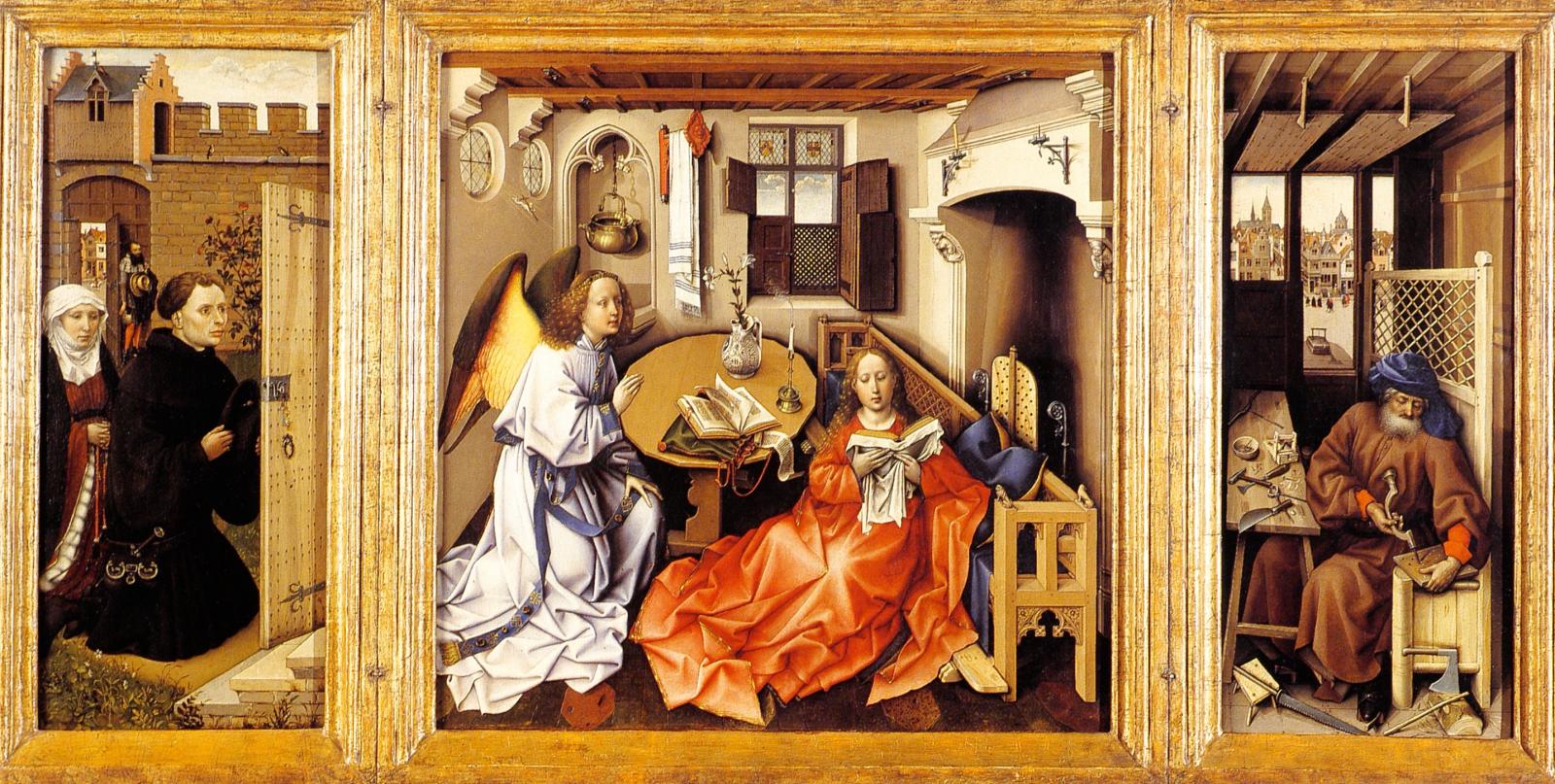
4 | Robert Campin and workshop, The Merode Triptych, c. 1420-1425, oil on wood, New York, Metropolitan Museum of Art, The Cloisters.
Larry Silver delves deeper into the chastity allegories, and sees a connection in the iconography of Gossaert's Danaë with the Annunciation, where gold beams of light shine at the head, ear, or stomach of the Virgin Mary [Fig. 4]. He writes:
The golden shower of the god's presence falls directly down on this young virgin's lap, just as the Virgin herself miraculously conceived at the time of the Annunciation. Often this conception, too, is depicted in religious paintings by means of golden rays of light, as in Merode Altarpiece (Silver 1986, 20).
.jpg)
5 | Francesco Colonna (attributed to), Triumph of Danaë, illustration from Hypnerotomachia Poliphili, 1499, woodcut, Venezia, Biblioteca Nazionale Marciana.
The Hypnerotomachia Poliphili, published by Aldus Manutius in Venice in 1499 for Guidobaldo da Montefeltro, Duke of Urbino (1472-1508), contains a woodcut with Danaë riding an antique carriage in a triumphant procession, surrounded by Christian chastity symbols, like the unicorn [Fig. 5]. At the bottom, the impregnation of Danaë takes place on her bed, and next to it, we can see the birth of Perseus.
Within the hybrid storm of fiery rain filling the room, at the same time, the syncretic space between Medieval purity ideals and the emancipation of Danaë as embodiment of Ancient virtues shone through. The humanist Pierio Valeriano (1477-1558) explains:
The poets related that gold poured into the lap of Danaei, the most beautiful of women. They mean by Danaei the beauty of the soul, which comprises the natural virtues that God loves; indeed, they signify by the “golden shower” the abundant flow of heavenly favor, which must be sought from the love and mercy of God. In truth, the abundance of all Blessings is given by God alone (Kahr 1978, 44-45).

6 | Adriano Fiorentino, Medallion for Elisabetta Gonzaga, 1495, bronze, London, British Museum, London.
In her article Elisabetta Gonzaga come Danae, Monica Centanni takes a closer look at the exemplary function of Danaë through examining a medallion by Adriano Fiorentino (1495) made for Elisabetta Gonzaga (1471-1526) (Centanni 2013) [Fig. 6]. The Duchess of Urbino, a loving and faithful wife and a “golden virgin” was doomed to sterility because of her husband's known impotence, but she hoped for a miraculous impregnation. The motto on the medal – HOC FUGIENTI FORTUNAE DICATIS – is an expression of her hope, suggesting that Elisabetta, like Danaë, had dedicated herself to Fortuna fugiens: the instant and unexpected Fortune (Helas 1999, 101-124; Baert 2020, 95-108). In 1495, Elizabeth still hoped she would share Danaë's fate. Here, Danaë has emancipated herself into a woman who, between modern virtue and Christian virginity, desires a late pregnancy.
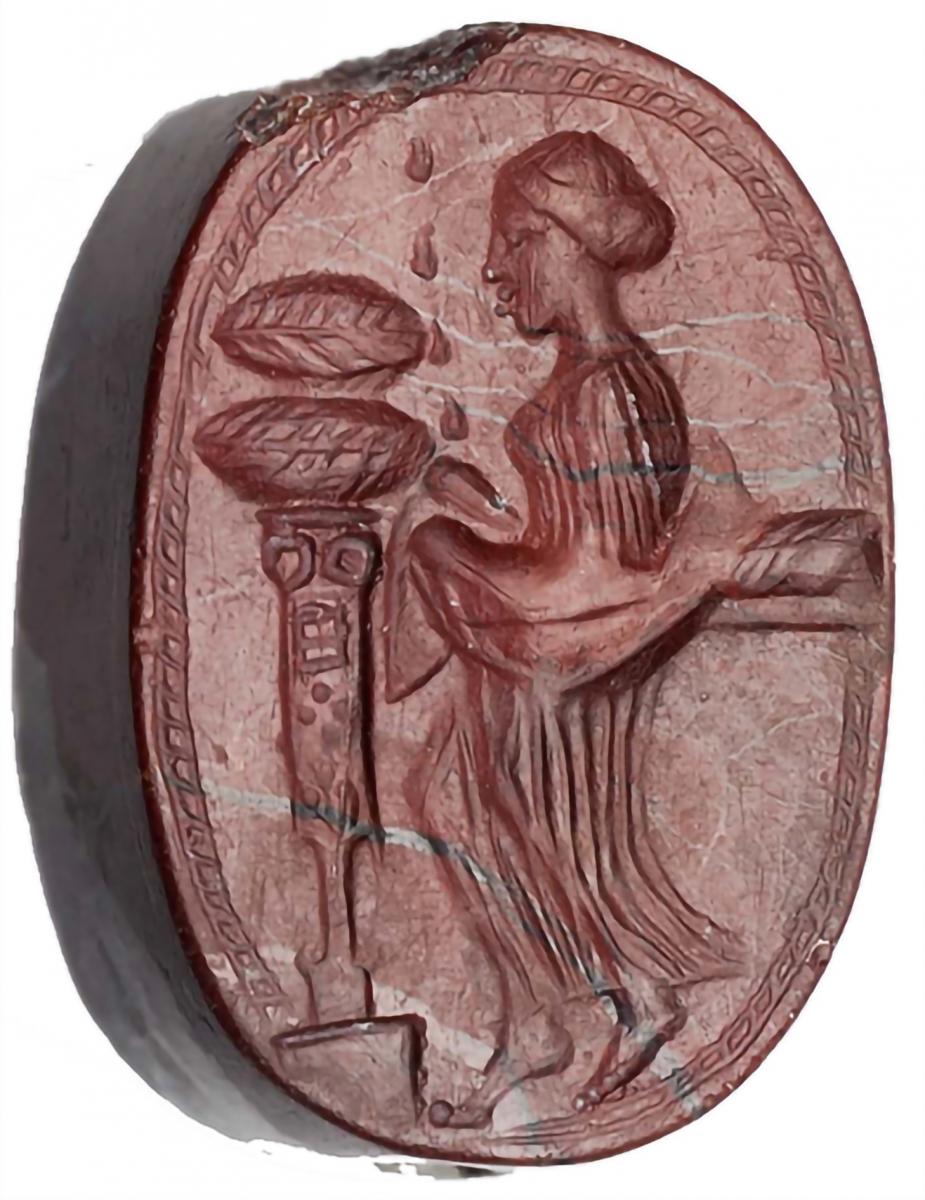
7 | Scaraboid (Danaë stands by her bed, holding out her dress to catch the golden rain sent by Zeus to impregnate her), Early Classical, engraved red jasper, Boston, Museum of Fine Arts (from Greece).
In her catalogue Man, Myth, and Sensual Pleasures. Jan Gossart’s Renaissance (2010), Maryan W. Ainsworth follows the humanist readings of Gossaert’s Danaë, as they were championed by Eric Jan Sluijter (Ainsworth 2010, 232-235). Sluijter completely pushes the religious interpretation from Panofsky's article aside and claims that the original Ancient myth was consciously being made erotic. Sluijter thinks that the suspected client – Philip of Burgundy – must have felt a connection to the theme for some reason, as a purist-humanist (Sluijter 1999, 4-45). Philip took a profound interest in classical texts and surrounded himself with humanists and artists. Moreover, Philip was a collector of gems and antique jewels himself, an important medium through which the Danaë iconography had been spread even during the Antiquity [Fig. 7].
I am of the opinion that the religious and humanist typology do not have to exclude one another. The contrast between the two is cancelled out within the “psycho-spatial space” (Raumlichkeit) (Saint-Girons 2007, 128-138). In Gossaert’s Danaë this space concerns the sophisticated articulation of an outer and inner discourse: the hard, dry, external space with its eclectic architecture, in contrast to the sweltering, moist, internal space of her naked body. I will develop Gossaert’s complex phantasmata surrounding architecture, decoration, and the female body in three phases: the space that allows access, the gendered space as (un)heimlichkeit, and finally the petrifying gaze.
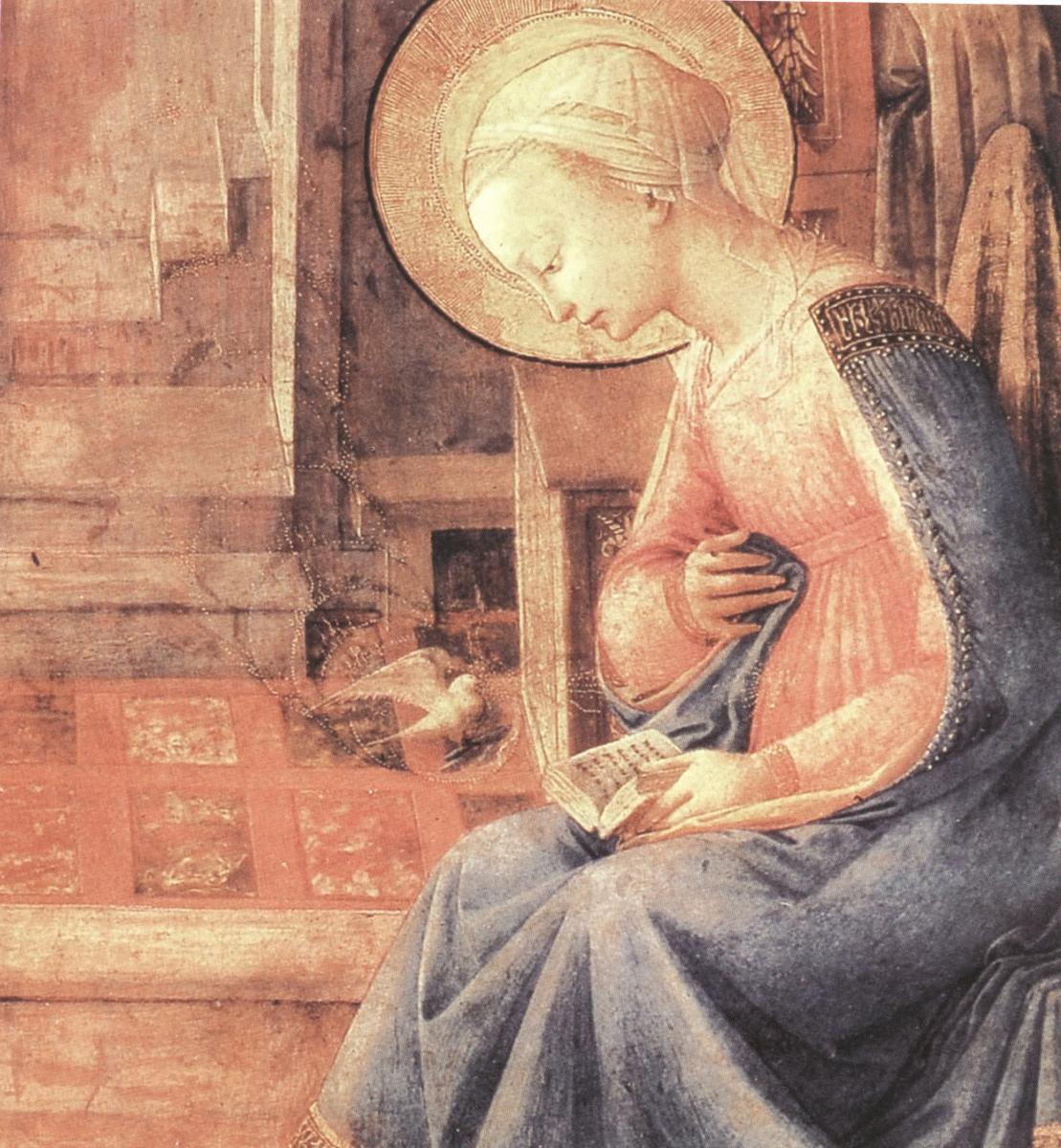
8 | Filippo Lippi, The Annunciation, c. 1448-1450, egg tempera on wood, London, National Gallery.
1. Access to intimacies
I will discuss the first phase – the space that allows access – based on its paradigm itself: the Annunciation (Baert 2015, 197-216). In his Le détail (1992) Daniel Arasse (1944-2003) directs our attention to Filippo Lippi's (1406-1469) Annunciation, which features a buttonhole without a button right at the navel (Arasse 1996, 338) [Fig. 8]. This minuscule opening can barely be seen with the naked eye. In his book, Arasse studies several details that are nearly invisible to the audience, and thus – so the author explains – should be seen as the enigmatic and intimate interwoveness between the painter and his art, which means this specific lost button could very well have a symbolic meaning. The tiny tear opening – exactly on the same horizontal line as the dove, the one who turns word into flesh – is for those who look for it a refined suggestion of the navel as a paradox of the closed opening (Arasse 1996, 340). But there is more: from the opening, small golden rays can be seen that in turn seem to answer those from the mouth of the dove. This would mean that Lippi suggests that the light of the word turned flesh is escaping from the stomach. The double beams of light also echo the 15th-century ideas about optics: sight comes from physical radiation that emerges from both the eye as well as the object. The meeting of these rays is what leads to visibility, which is repeated in the fertilizing energy radiating outward and that of the Holy Spirit. The strange consequence is that the opening at the navel seems to act as a third eye (blind yet still visionary), as an internal (endoscopic) way of looking and as a uterine, virginal look. Because the closed opening that is the navel is the mark and scar of that which we cannot remember: fetal life within the mother's womb.
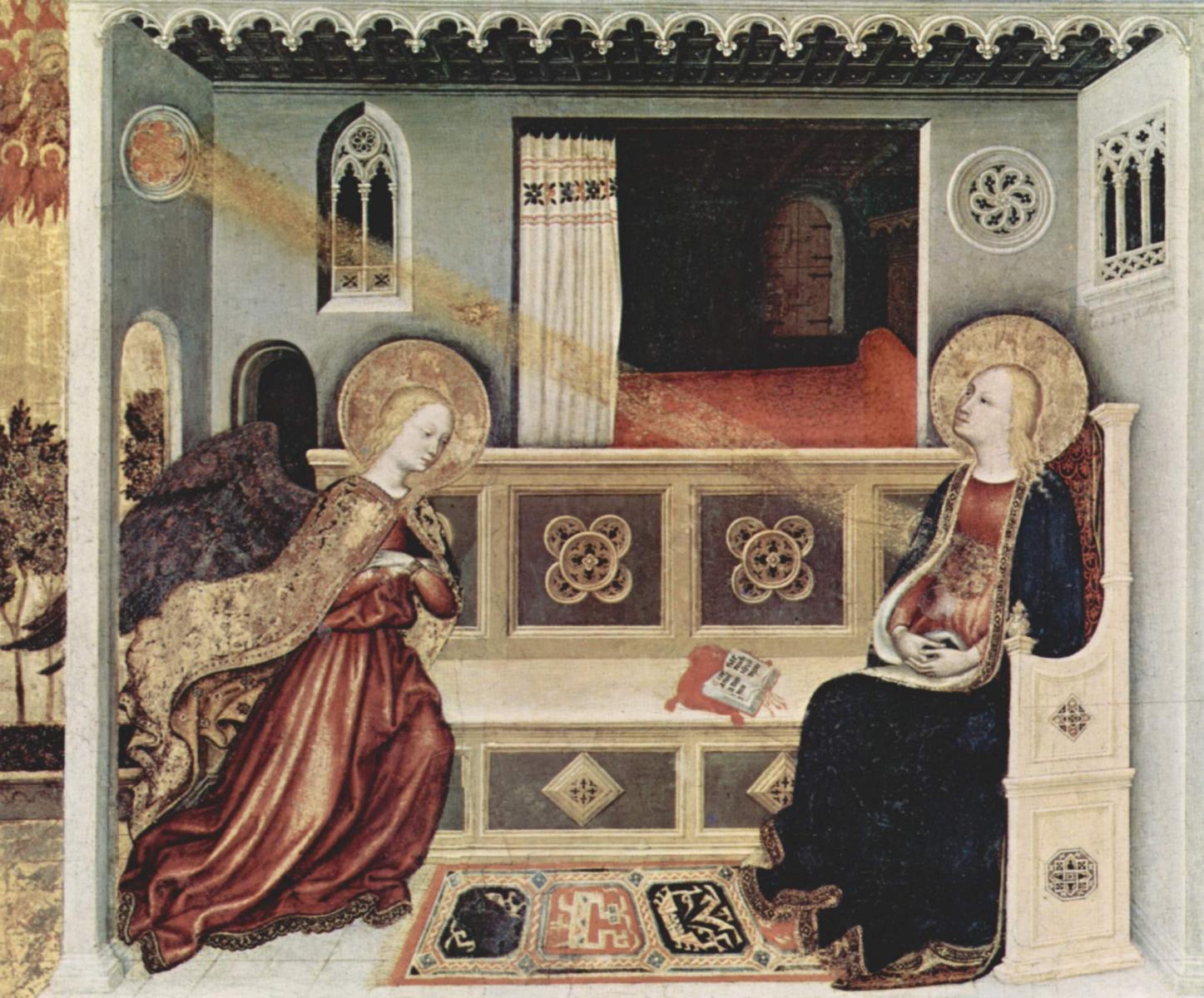
9 | Gentile da Fabriano, The Annunciation, c. 1421-1425, tempera and gold leaf on wood, Rome, Vatican Museums.
Filippo Lippi's detail of the navel was possibly a virtuous refinement of an old Tuscan tradition. On the altarpiece by Gentile da Fabriano (ca. 1370-ca. 1427) a beam of light escapes from God's chest and penetrates Mary's room through a skylight, ending just below her heart, while the six-lobed oculus shines a light on her lower body [Fig. 9]. The 'eye' of Mary's room is repeated as an optic photogram: she carries the divine light of the supernatural impregnation in a pictorial manner. The light has descended in painterly virtuosity: the subtle golden rays, the hidden energy of the dove, and the optical echo of the window on the textile. This also makes Mary's womb a type of ‘receiving eye’.
The belly looks. It receives from the eye that looks and touches. The eye, that black, dangerous pupil with its illuminating particles follows the then contemporary ideas on optics with Danaë and Mary as a permeable ‘window eye’.
Here, we can find a relationship with the Song of Songs. Canticle 2:9-10 says: “Look, there he stands behind our wall, gazing in at the windows, looking through the lattice. My beloved speaks and says to me: ‘Arise, my love, my fair one, and come away’.” Origen (184-253) interpreted this passage of the Canticum as follows. The word of God, the bridegroom, is found not in the open courtyard but covered over and as it were hiding behind the wall as in a teichoscopia. He would first look through the window at the Bride. With a leap he reaches the window of the house, having in mind to peep at her. This is peeping in the time when she will unveil her face to go outside and to find him (Cox Miller 1986, 241-253). Moreover, the word window originates from the Old Norse ‘vindauga’, from vindr, ‘wind’, and auga, ‘eye’; that is, wind eye. In Norwegian Nynorsk and in Icelandic, the Old Norse form has survived to this day (in Icelandic only as a less used synonym to gluggi); in Swedish the word vindöga remains as a term for a hole through the roof of a hut, and in Danish ‘vindue’ and in Norwegian Bokmål ‘vindu’, the direct link to ‘eye’ is lost, just as it is in ‘window’.
Back to Gossaert’s Danaë. The scene takes place in a splendid Antique hemicycle with red marble tiles and ionic columns with Corinthian capitals. Above it lies a golden frieze with bucrania that opens up with several oculi. A lintel finishes off the room, with a border at the top of the painting featuring a golden cherub, who watches the mysterious happenings from above happen below him, with the eyes of the gods and the boustrophedon, as it were. Here in this space, Danaë waits. The parallels with the Annunciation are clear. In both cases, the impregnation is passed along through the air, expressed as a golden material. In both cases, the woman is 'surprised' by it (Lucas 1:30: “Do not be afraid!” Lucas 1:34 “How can this be?”). Especially in the case of Gossaert's Danaë, the architecture facilitates these 'elements of surprise' – bay windows, pillars, grates, openings, windows – and thus demands entrance into the womb as if it were a matter of course.
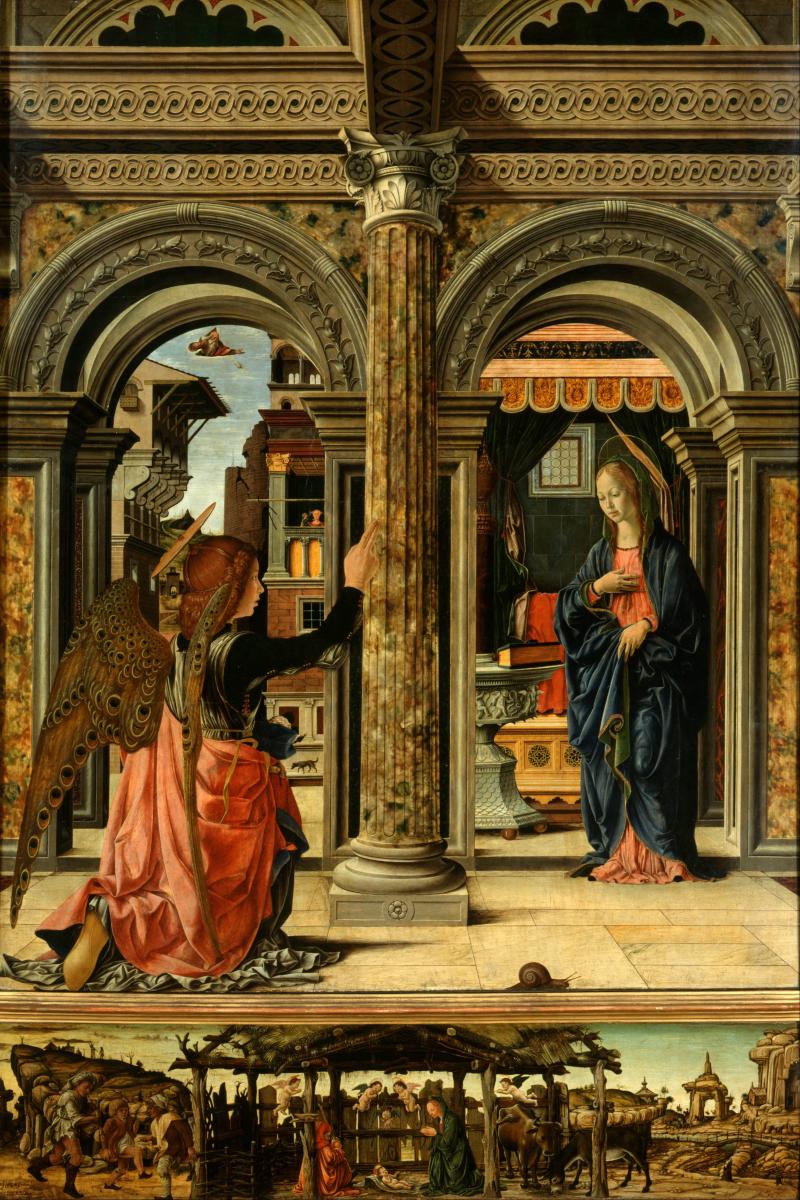
10 | Francesco del Cossa, The Annunciation, 1470-1472, Tempera on panel, Dresden, Gemäldegalerie Alte Meister.
How closely does Gossaert's work resemble that of Ferrara painter Francesco del Cossa (1430-1477) [Fig. 10]. His Annunciation (1470) preserved in Dresden is also a lively, even an idiosyncratic event that takes place in a complex architectural setting with numerous vistas (Manca 2001, 55-63). Behind a double arcade arch with a monumental column that seems to be supporting a portico, we see Mary in a private chamber of the time. The bedstead is open and a stone fountain can be seen, perhaps a reference to the epithets of the Blessed Virgin, Canticle’s “sealed fountain” (4:12) and “spring of living waters” (4:15). In the distance a dog is strolling past a palace. The young mother and her infant looking out the window have no inkling of what is taking place a little further, close to the viewer. They are in the present, but (as of yet) unaware that in the foreground a new era is tearing open: when the angel landed gently and spoke fittingly. When Mary was jolted from her concentration.
Now we have arrived. The impregnating space is the mythical space drenched with the secret: impregnation, threats, loneliness, the curse of the past, hope for the future. This space filled with the mist of ancient patterns, questions the origin of that secret, but also frames it in a story, controls its effect, and keeps it safe from harm in isolation.
2. The gendered space as (un)heimlichkeit and voyeurism
In his article Drop Form. Freud, Dora, and Dream Space, Spyros Papapetros asks the following questions:
Does psychoanalysis have a theory of space? Is there any relation between the origin of modern theories of architectural space in the last quarter of the nineteenth century and the institutionalization of Freud’s therapeutic practice around 1900? If yes, how does his dream interpretation move beyond the symbolic identification between interior organs of the body and the interior spaces of a building to offer a new form of correspondence between subjects, objects, and the architectural settings that enclose them? (…) In other words, would architectural objects cover up (like added ornamental layers) or expose the inner core of psychoanalytic constructions? (Papapetros 2015, 59).
These questions bring me to the second phase.
Through the windows of the elegant tower, which was Danaë’s vengeful prison all the same, we can see an eclectic collection, or, better yet, an extravagant amassment of architecture that functions more like a cabinet of curiosities: a Renaissance palace, flamboyant Gothic façades, Italian domes, and lanternae. Gossaert touches on an écriture that pays homage to decentralization, fragmentation, proliferation, fluttering contours and the ungraspable. These traits of side effects in motion may seem seductive at first, but deeper down they are perceived as disturbing. The hypermotility of these ‘surges’ appears to translate into a corporeality that no longer fits into the old formal language. Paul Vandenbroeck has explored the possibilities of this opening further on the basis of the stylistic fault line, or locus, of the threshold in a ‘forming-feeling’ (Vandenbroeck 2004-2005, 301-330). According to Vandenbroeck, such (apparent) anomalies or transitions along the artistic timeline arise when a controlling gaze is no longer considered sufficient, and the artistic psyche rages out of control in search of new outlets. This process – which actually entails a stylistic revolution – ensures that new artistic autonomous zones must be explored and exploited: a new genius loci of style. Paul Vandenbroeck compares the new genius loci of style with pictorial chora: the site of the artist’s contribution, autonomous and charged with meaning, but at the same time a new site that can be mined for spontaneous, partly unconscious expressive forms: the parergon and Beiwerk (Margaroni 2005, 78-98). This new, rebellious écriture pays tribute to rampant growth, thereby becoming a wild, almost neurotic pictorial language.
Gossaert created a world within the chora with the immanent secret and the impossible, utopian, shamelessly exhibitionist world outside of it. Through the uncompromising windows we see façades, bay windows, balconies, and different marbles accelerate in a frantic choreography of Ancient taste, while at the same time the lust, the excess, and the impertinence is brewing, much like that of the Supreme God, who will soon discharge his gleaming seed. This astonishing impregnation is made possible against the phallic background, which reproves any sublimation, any attempt at metaphorical readings. The explicit dominates the implicit. And there, painfully alone, an Ionic-Corinthian 'possession' takes place. She who looks up calmly – quomodo, surprised – at how this golden pillar of light drenches her. Light pouring through the grate. Seed from the oculus. A woman's body exposed between the pillars, membranes, openings.
This brings me to the interesting study by Ernst Fischer, Writing Home. The author introduces the female domestic space as the uncanny space with particular ‘spatial-markings’. “Architecture introduces a necessary third term, namely ‘house’ in addition to ‘space’ and ‘home’. (…) The house is a fiction made concrete, a perspectival grid that shapes and marks the bodies in houses according to the very ideology of visibility in the name of which it is itself constructed” (Fischer 2001, 123). Spatial-markings – demarcations between inner and outer discourse/architecture – possess the capacity to be linked to the intimacy and spatial demarcation in the house/household or the notions of Heimlichkeit and secrecy. It is interesting to see that precisely the notion of Heimlichkeit/secrecy derives from secretum, which in turn is derived from segregation, separation.
It seems pertinent in this connection to recall the Latin definition of Heimlichkeit/secrecy as an act of separation, and to note that according to Arnaud Levy, the word originates with the sifting of grain with the purpose to separate the edible from the non-edible, the good from the bad. The separation is effected by a hole, an orifice, whose function is to allow something to pass or not pass, depending on the relation of the objects shape and size to the shape and size of the hole. Hence, the sifting process allegedly constitutes a metaphorical representation of the anal function. (...) The production of Heimlichkeit in the sieve of the house is achieved through a process of excretion: the separation of the homely from the abject (Fischer 2001, 124; Levy 1976, 117-130).
The voiding function of architecture as ‘home’ arises with Alberti’s reference to the metaphor of chastity (Wigley 1992, 332).
Entering the house as spouse is immobilized and secreted through confinement in a hierarchically arranged sequence of private spheres. Within this spatial order, the woman is further sub-divided and ultimately effaced as sexual, desiring subject by being put in her proper place among her husband’s possessions. She is declared pleasing for knowing her limits defined by: ‘... surveillance over a particular space, whether it be the dinner table, the threshold, the church, the fingertips, the bath, the face, the street’ (Fischler 2001, 125).
This reminds me of Origen’s comments on the earlier discussed passage in the Song of Songs: “Behold, he stood behind our wall, leaning against the windows, looking through the nets”. In his commentary, Origen struggles with the spatial settings of the song. It’s true that inside and outside are confusingly muddled, such as noted here, ‘behind the wall’ and ‘through the nets’ (Lawson 1957, 230). The exegete explains this with the classical gender contrast. Because the groom, as a man, is not always home, whereas the bride is always at home waiting for him, the groom sometimes speaks as though he is inside the house, and sometimes as if he is outside of the house. The verse “looking through the lattice” is in this sense a ‘scopic mediator’: a grid between male and female framing, a border that is only crossed visually, through a loving gaze, in this case. The grid structure of the lattice adds to the ambiguity of the privacy and permeability, of keeping out and opening up.
Fischer radicalizes these positions. According to Fischer, womanhood means vanishing. The female dissolves into intimate space. Her clothing can no longer be distinguished from the interior wall coverings onto which the man projects himself.
The woman is thus paradoxically not only locked up in the architectural grid, and abjected through the holes of the sieve, she becomes those very holes. In the domestication of space as place, its unbroken expanse is punctuated by row upon row of orifices. The art of husbandry in this sense lies in the cultivation of, to use [Gilles] Deleuze (1925-1995) and [Félix] Guattari’s (1930-1992) term, ‘a field of anuses’(Fischer 2001, 125; Deleuze, Guattari 1988, 32).
Besides the permeable screen, the woman also becomes the dissolving screen. She evaporates into the walls of the house and becomes a writeable, definable canvas for male desires and anxieties. In his Della famiglia, Leon Battista Alberti writes that it strikes him as “somewhat demeaning to me to remain shut up in the house among women when I have manly things to do among men,” in contrast to “those idle creatures who stay all day among the little females” (Alberti, Fam., 207). Staying indoors apparently has an ‘unmanning’ effect. “The confinement of the interior space is transferred in an optical shrinking process onto the occupant, turning him into a tiny inside-out projection of himself: ‘a little female’ occupied with ‘trifles’. The immobilized phallus shrinks and shrivels and wastes away through the sieve’s hole, to become a hole itself” (Fischer 2001, 125).
In connection to that, I would like to refer to Mona Hatoum’s (Beirut, 1952) sculpture Grater Divide from 2002. The installation consists of a giant kitchen grater. Hatoum often uses the grid or geometric forms to reference systems of control within society. Also, in this case, she uses a household object that is scaled to make it familiar yet uncanny (Antoni, Hatoum 1998, 54-61). At the same time, this grater/grid is shaped like a room divider, a foldable paravent, used to create private spaces within a room. The above-mentioned Heimlichkeit, or the space of the secrecy, is literally enlarged. Because of the absurd scale of the grater, Grater Divide posits the paradigm of limitation as a threat (amplified by the wordplay between grater and greater). This architectural grid, with its obscenely large openings, derived from commonplace kitchenware, confronts us with pain and destruction in an audacious manner. The normally so refined and distinguished room divider, part of the intimate world of the woman and her body, is now a weapon from the depths of the kitchen cabinets. The erotic ‘performative’ paravent that used to invite people to sneak a peek becomes a perversely ‘perforated’ paravent. The world of food preparation – also classically seen as women's domain – is now part of the intimate space of the bedroom, and that clash, this ‘blowing up’ does away with the “separation of the homely from the abject:” Heimlichkeit becomes Unheimlichkeit. The holes are threatening; they’re not soft eyes, but the mal occhi that stare at us from the lands of Sodom and Gomorrah.
In Fischer’s approach we learned about architecture and membranes into which female intimacy can empty itself (emission), but into which it can also disappear, as into the hollows of tectonics itself. In Hatoum’s interpretation, these hollows of tectonics became abject, aggressive, wounds even, as well as an absurd blurring between kitchen and the privacy of the private room, two feminine spaces par excellence.
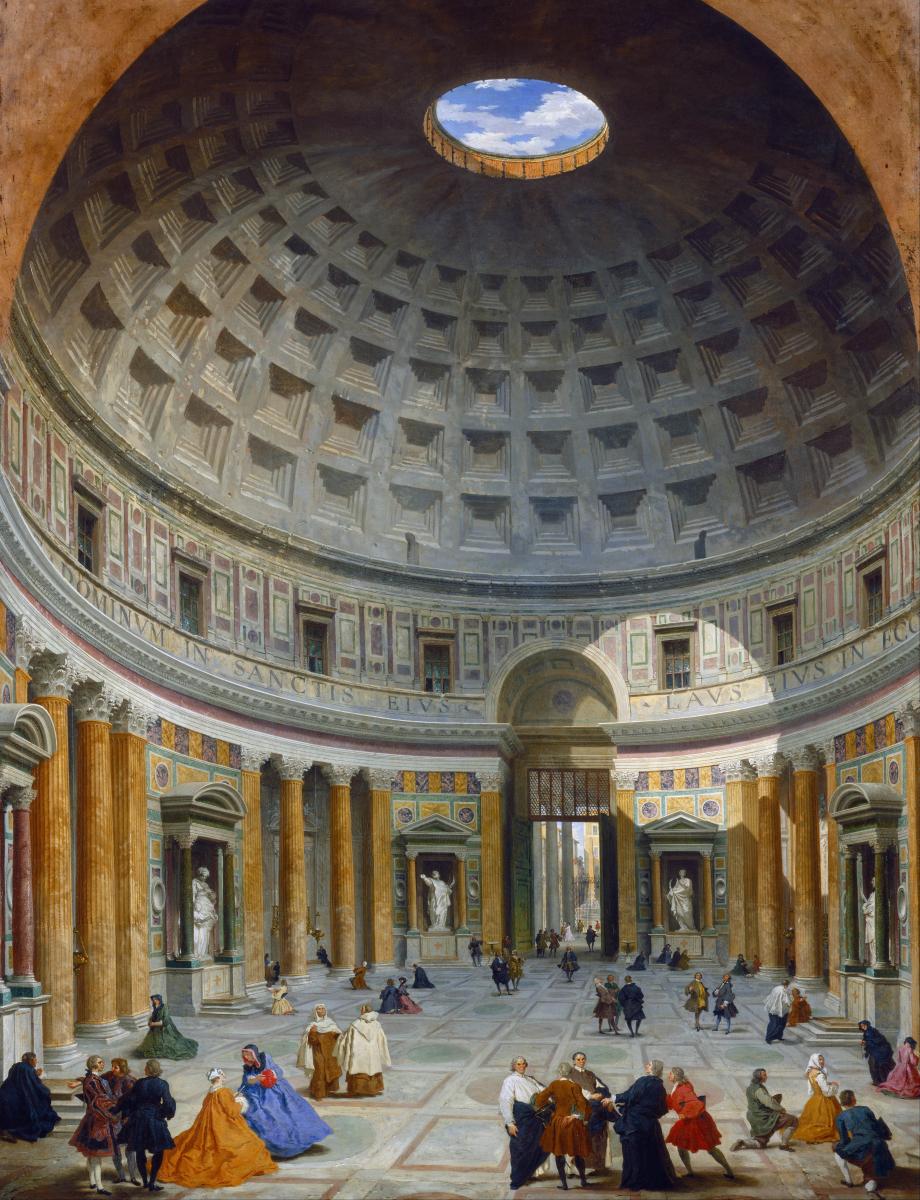
11 | Giovanni Paolo Panini, Interior of the Pantheon, c. 1734, oil on canvas, London, National Gallery of Art.
3. Space as the petrifying gaze of Medusa
Gossaert and his Danaë had come to the third phase. The final act. Reverberating, echoing, shrill inner and outer windows. Never enough. Panic-Escherian engulfing each other. The window of the painting we come through as the sharp, clinical intersection of an eyeball. Who wants to see this? Not yet enough. The window above: the impregnator, the black Magna Mater pupil through which Zeus spews his rain of seed. Look, it is falling. A female body placed directly under the leak of the Pantheon [Fig. 11]. Marian cobalt blue for the tempering (such hypocrisy). Not yet enough. Golden rain drops, a viral aerosol of prying eyes and twittering beaks. Zeus as the impregnating boustrophedon: the look from above like Mary being greeted by the angel in golden letters, being moaned down into her ear, from behind [Fig. 12].
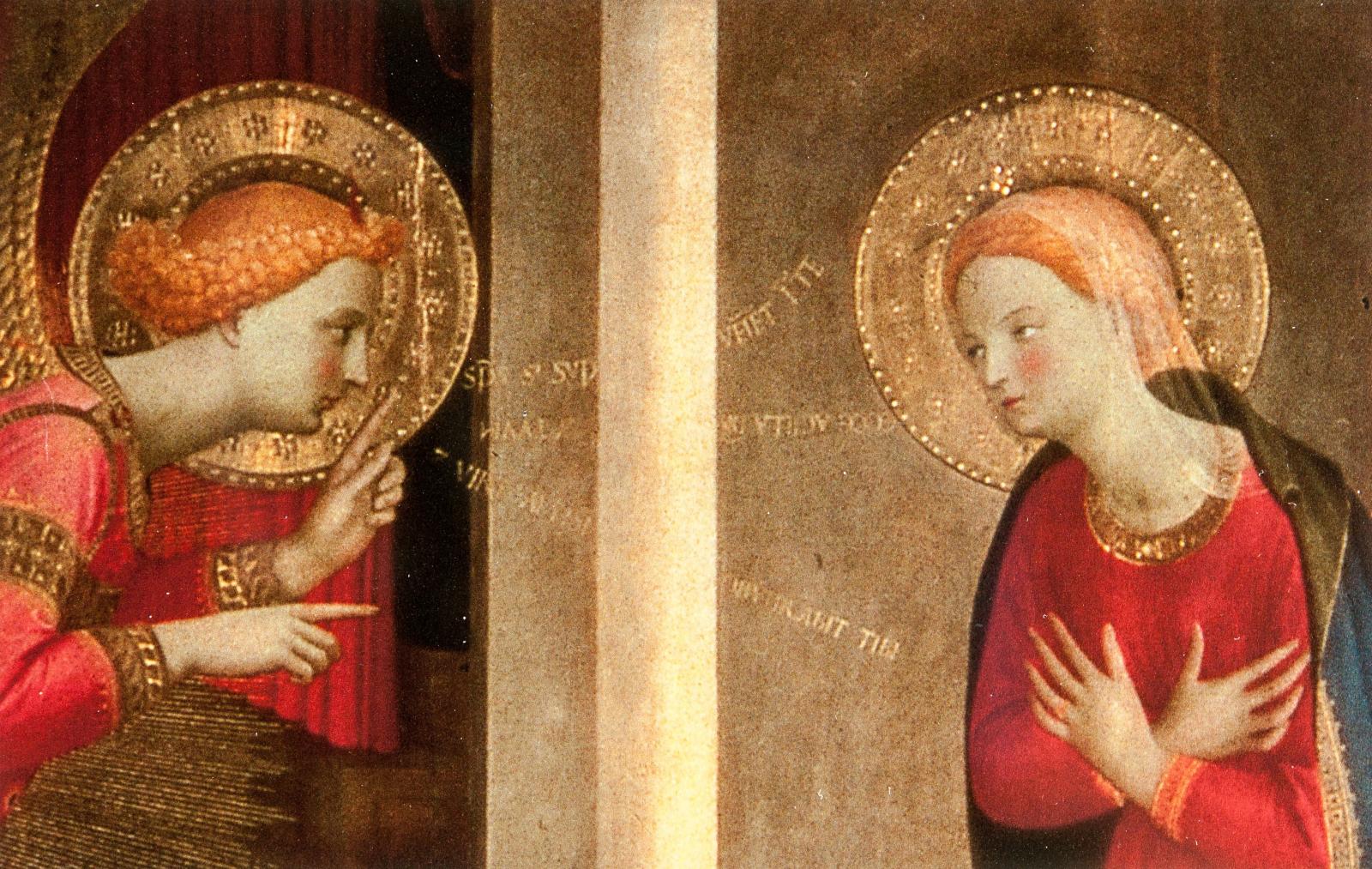
12 | Fra Angelico, The Annunciation, c. 1433-1434, tempera on wood, Cortona, Museo Diocesano, detail with boustrophedon.
(The cherub on the lintel has demanded the scene; we do not know from what iconography he has wrestled himself free.) Not yet enough. The worst is yet to come. The explosion of windows in the outside discourse. The mannerist perversion. A multitude of eyes: balustrades, glass windows, open roof lanterns, plazas, bay windows, window frames, corner windows: oculi, oculi, oculi! And then: the echo in the glass work, the prisms of sunlight, the rainbow on a wall, the cold white marble that soaks up all the light, veins like scars of sun beams that did not manage to escape - the vengeful prison of faint rays of sunshine - and the crust, matte, opaque, flakiness of a once shiny golden drop of semen. The trail of slime of Francesco del Cossa’s slow snail as rebuttal for the softly cascading plume (Arasse 2000, 37) [Fig. 13].
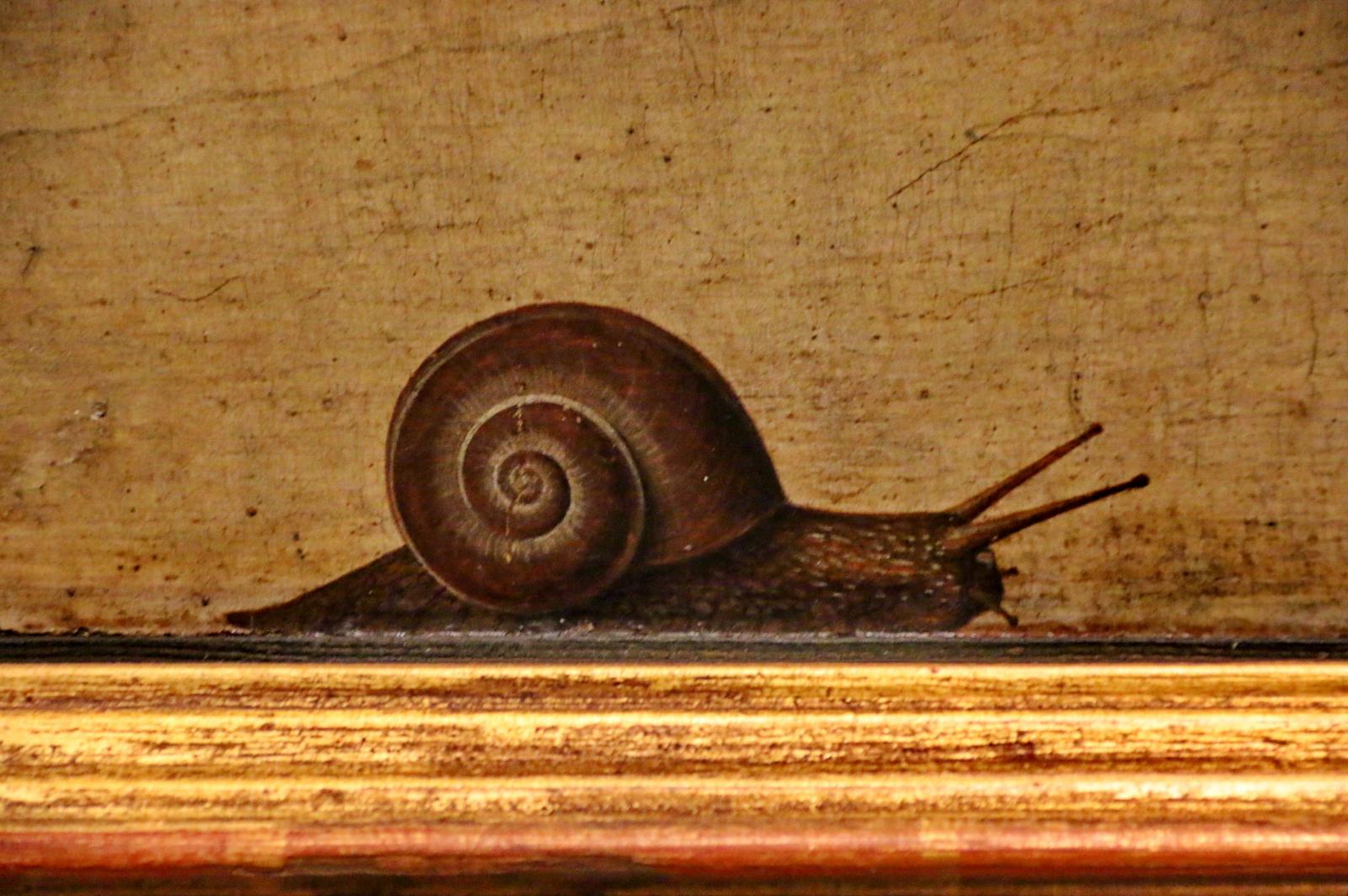
13 | Francesco del Cossa, The Annunciation, 1470-1472, Tempera on panel, Dresden, Gemäldegalerie Alte Meister, detail of the snail.
How much complexity, how many thick, cold walls with refined protruding bay windows, how much beautifully displayed architecture is needed to be able to handle the thinnest, most delicate, permeating membrane of a woman? How poignant is this male counterbalance, how ridiculous is this over the top attack on this bit of tissue, a transparent membrane? Who can endure such a thing? Who wants to see this? This is the ruthless space in which Danaë is held hostage. Gossaert did not close off her tower like in the Song of Songs, but has shamelessly opened it up - ionic, Corinthian - and abandoned Danaë to a million prying eyes. Everyone from outside can look in. And everyone sees us, readers, hesitating, shuffling at the threshold of this painting. Who wants to see this? Who wants to be part of so much ejaculating voyeurism and horny gravity? Who? “That look is so powerful that it wears down even the strongest man. It is as powerful as the touch of a hand, as if you were constantly being stroked. It drives you mad (Márai [1942] 2001, 71)”.
And now, I think of the back side of the window. The black pane we cannot see, the wall against which the cold backs lean of those thousands of frightful eyes that pry into Danaë’s back. Again. What look survives this cold back side, what look is powerful enough to escape from Danaë’s look, our look, Zeus' pay-by-the-hour room, from the merciless multiplication of this delirious phantom architecture? What look is powerful enough to be able to survive these endless replicas?
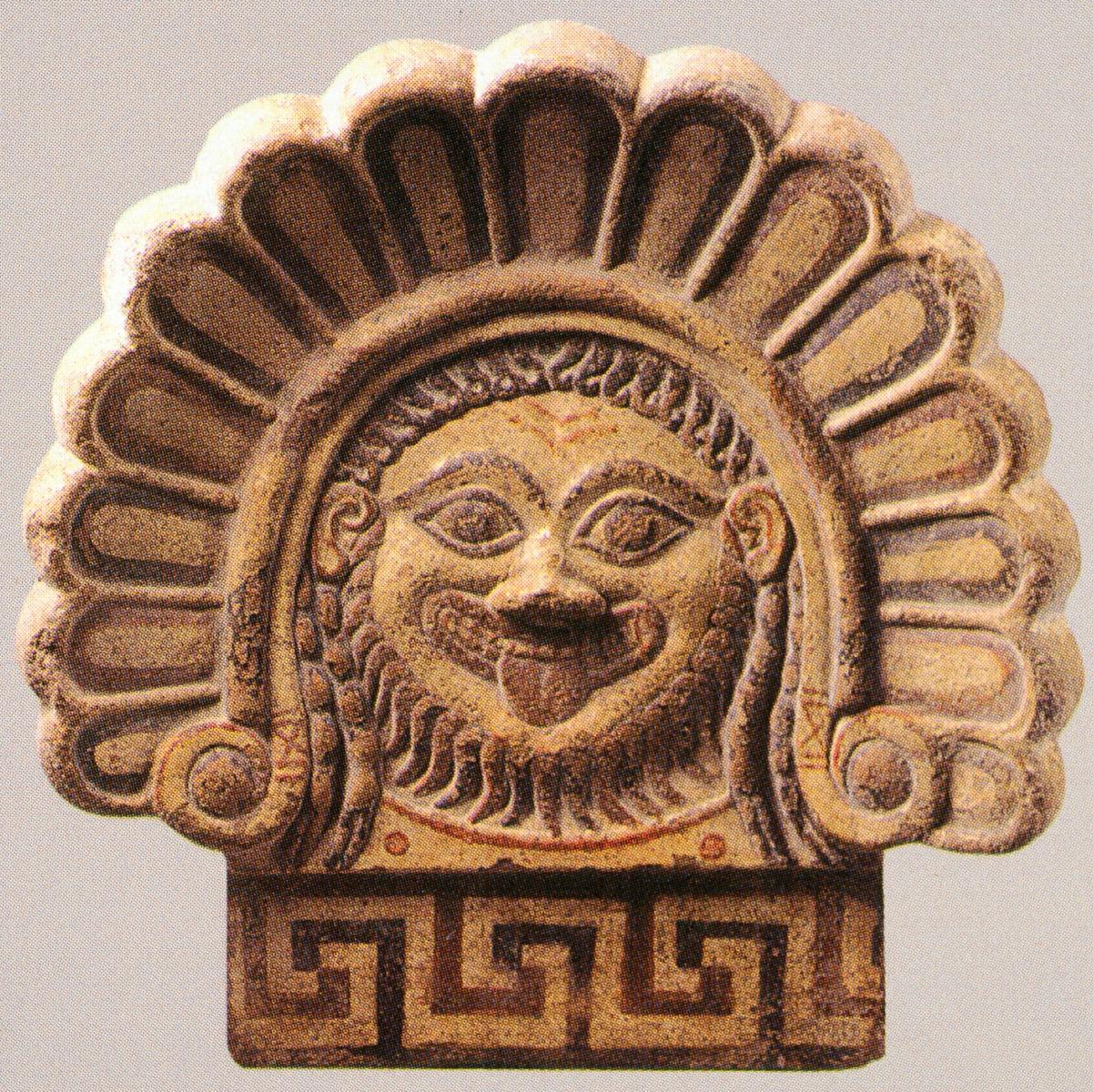
14 | Etruscan head of Medusa, c. 500 BCE, terracotta with polychrome, Naples, Museo Archeologico Nazionale (from Santa Maria Capua Vetere).
The answer is the greatest taboo possible. The taboo that Danaë created for her son: Medusa [Fig. 14]. Gossaert painted the prolepsis of this genius trap around her neck, which would spawn the snake pit of all the arts (Barale 2013, passim; Kristeva 1998, passim). And thus, it is not only the rain that slips in like golden drops, but also the rain in its most ancient grapheme: the snake as boustrophedon. The catastrophic look outwitted by Danaë's son. The doom that was called down upon him, but was averted in time. Danaë still guards over her son. What her father wanted to do to Danaë, Perseus did to Medusa. Two fatalities thwarted in one generation. The look is irrevocably diverted by the trick with the mirror. And thus the world was saved from inevitable sclerosis in one fell swoop. That look that is so taboo one cannot speak its name, nor depict it. But the gift, yes, the 'immanent secret' is the birth of form from red coral, of the arts themselves.
As Marisa Bass writes in her Jan Gossart and the Invention of Netherlandish Antiquity: “Danaë’s womb, according to the windy trajectory of classical myth, was the origin of artistic invention. (…) Gossart’s Danaë assertively dramatizes its own material origins. As Danaë lifts the luscious swath of blue fabric draped across her thighs and welcomes the god’s descending bounty, Gossart figures the womb of concealed beneath those heavy folds, the mythical point of inception for all artistic inspiration and, by extension, for his painting itself” (Bass 2016, 116).
We can also add Kostas Tsiambaos’ interesting point: “And, if considering the ground plan as the “birthplace” of architectural form speaks to us about the earth as a matrix of forms and shapes, then this movement of return to the past is identified with an initial desire of return to an ancient chora, the primitive Mother-Earth” (Tsiambaos 2018, passim).
And even further away, back in time. The 4th century Orphica says that when the blood of Chronos dripped down on the earth haematite was formed: “A leech come down from heaven” (Barb 1948, 67). What drips and impregnates shall become form: wet golden beams on a lap.
The pearl drops absent from Dora’s jewel-box are not marginal details in Freud’s analytic reconstruction of her dreams - they are models of their inner space, or even kernels presaging the ultimate dissolution of that space. These tropfenförmig pendants are then not only shaped like “drop forms” but their very purpose is to drop form: to drop the very concepts of space and form entirely by shifting the meaning of “[t]ropfen” from a plural noun into an active verb that both collapses and enfolds dream space towards a radical re-form of human subjectivity (Papapetros 2015, 87).
Not yet finished.
Looking back again at Danaë.
On the edges of the taboo that overcame Orpheus.
I see the light that splashed into the tower from left to right. The light that is needed to light up the transparent, sticky semen, to transform it into the gold that descends deeply and perfectly into just the right place. This light which also bathes the hard marble eyes of the outside in a midday sun. Silent, Mediterranean, scorching heat. Our southern facing window. Again we have the démon de midi: for a single moment time freezes because of a supernatural rain that falls from the heavens. You and I, with our curious, wrinkled looks, are placed in the north just like that. The compass turned upside-down. Zeus' discharging gravity – his rain – shoots from south to north. The geographic convention tipped from the divine cosmological point of view: again, we have the boustrophedon.
The eastern breeze brings with it the light by way of Eurus's chariot, and subtly lifts Danaë veil. There is no gold here. No male stain, but the millennia-old aegis fluttering down, delicate and transparent like a spider's web. And Homer sings: “So saying he smote upon her tasselled aegis [or: her aegis with many a tassel fraught] – the awful aegis against which not even the lightning of Zeus can prevail – thereon blood-stained Ares smote with his long spear” (Iliad XXI, 400).
And what is Danaë's hand doing there in its velvet limbo? A hand measuring the heat of the sultry seed? A hand as blindfold against so many oculi? A hand that becomes one with the luxurious moist drapes within the calm unrest of the secret? The inside of the woman turned inside out in cobalt blue? L’inflecton inhérence du pli, Gilles Deleuze writes (Deleuze 1988, 31). And Gabrielle Brandstetter adds: “Der jeweilige Zustand der Faltung in einem Stoff-Material, seine Imprägnierung mit Energie und Spannung überträgt sich in den Fall des Faltenwurfs, entlädt sich in den Knicken und Schwüngen des drapierten Gewands” (Brandstetter 2000, 113). The implicit dominates the explicit. Danaë and her pressing burden of what cannot be seen. Not yet finished: the corner of the pillow with its round, red head drones past: the cul-de-sac of our moving gaze. Now we have arrived. Here, Medusa banishes us from the painting. And the black tassels of Athena’s aegis still murmur about the shame of that much male opportunity.
Bibliografia
Fonti
- Alberti, Fam.
L.B. Alberti, Family in Renaissance Florence, translated by R. N. Watkins, Columbia 1969. - Colonna, Hypn. Pol.
F. Colonna, Hypnerotomachia Poliphili, G. Pozzi, L.A. Ciapponi (eds.), vol. I, Padua [1449] 1964.
Riferimenti bibliografici
- Ainsworth 2010
M.W. Ainsworth, Jan Gossart. 35. Danae, in M.W. Ainsworth (ed.), Man, Myth, and Sensual Pleasures. Jan Gossart’s Renaissance. The Complete Works, exh. cat., London-New York 2010, 232-235. - Antoni, Hatoum 1998
J. Antoni, M. Hatoum, Mona Hatoum, “BOMB – Artists in Conversation” 63 (1998), 54-61. - Arasse 1996
D. Arasse, Le détail. Pour une histoire rapprochée de la peinture, Paris 1996. - Arasse 2000
D. Arasse, On n’y voit rien. Descriptions, in É. Vigne (ed.), Collection Folio Essais, 417, Paris 2000. - Baert 2015
B. Baert, The Annunciation and the Senses. Ruach, Pneuma, Odour, in Between Jerusalem and Europe: Essays in Honour of Bianca Kühnel, “Visualizing the Middle Ages” 11, Leiden 2015, 197-216. - Baert 2019
B. Baert, About Sieves and Sieving. Motif, Symbol, Technique, Paradigm, Berlin 2019. - Baert 2020
B. Baert, Afterlife Studies and the Occasio Grisaille in Mantua (School of Mantegna, 1495-1510), “Ikon” (2020), 95-108. - Barale 2013
A. Barale, Perseus and Medusa: Between Warburg and Benjamin, “La Rivista di Engramma” 105 (aprile 2013). - Barb 1948
A.A. Barb, St. Zacharias the Prophet and Martyr. A Study in Charms and Incantations, “Journal of the Warburg and Courtauld Institutes” 11 (1948), 35-67. - Bass 2016
M. Bass, Jan Gossart and the Invention of Netherlandish Antiquity, Princeton 2016. - Brandstetter 2000
G. Brandstetter, "Ein Stück in Tüchern". Rhetorik der Drapierung bei A. Warburg, M. Emmanuel, G. Clérambault, in W. Kemp et al. (ed.), “Vorträge aus dem Warburg-Haus”, vol. 4, Hamburg 2000, 107-139. - Centanni 2013
M. Centanni, Elisabetta Gonzaga come Danae nella medaglia di Adriano Fiorentino (1495), “La Rivista di Engramma” 106 (2013). - Corboz 2000
A. Corboz , La "Danae" di Mabuse (1527) come testimonianza dell'idea di Sancta Antiquitas, “Artibus et Historiae” 21, 42 (2000), 9-29. - Cox Miller 1986
P. Cox Miller, Pleasure of the text, Text of Pleasure. Eros and Language in Origen’s ‘Commentary on the Song of Songs, “Journal of the American Academy of Religion” 54, 2 (1986), 241-253. - Deleuze 1988
G. Deleuze, Le pli. Leibniz et le Baroque, Paris 1988. - Deleuze, Guattari 1988
G. Deleuze, F. Guattari, A Thousand Plateaus, London 1988. - Dube 1974
W.D. Dube, The Pinakothek Munich, New York 1974, 122-124. - Fischer 2001
E. Fischer, Writing Home. Post-Modern Melancholia and the Uncanny Space of Living-Room Theatre, in P. Campbell, A. Kear (eds.), Psychoanalysis and Performance, London/ New York 2001, 115-131. - Friedländer 1930
M. Friedlander, Jan Gossart and Bernart van Orley, Berlin 1930. - Heckscher 1961
W.S. Heckscher, Recorded From Dark Recollection, in M. Meiss (ed.), De artibus opuscula XL. Essays in honor of Erwin Panofsky, New York 1961, 187-200. - Helas 1999
P. Helas, Fortuna-Occasio. Eine Bildprägung des Quattrocento zwischen ephemerer und ewiger Kunst, “Städel-Jahrbuch” 17 (1999), 101-124. - Kahr 1978
M.M. Kahr, Virtuous, Voluptuous, Venal Woman, “The Art Bulletin” 60, 1 (1978), 43-55. - Kristeva 1982
J. Kristeva, Desire in Language. A Semiotic Approach to Literature and Art, New York 1982. - Kristeva 1998
J. Kristeva, Visions capitales, Paris 1998. - Lawson 1957
R. Penelope Lawson (ed.), Origin, The Song of Songs. Commentary and Homilies, “Ancient Christian Writers” 26, Westminster 1957. - Lissarrague 1996
F. Lissarrague, Danaé, métamorphose d’un mythe, in S. Georgoudi, J.-P. Vernant (eds.), Mythes grecs au figuré de l’antiquité au baroque, Paris 1996, 105-133. - Levy 1976
A. Levy, Evaluation etymologique et semantique du mot “secret”, “Nouvelle revue de psychanalyse” 14 (1976), 117-130. - Manca 2001
J. Manca, Style, Clarity, and Artistic Production in a Courtly Center. Some Myths about Ferrarese Painting of the Quattrocento, “Artibus et Historiae” 22, 43 (2001), 55-63. - Márai [1942] 2001
S. Márai, Embers [A gyertyák csonkig égnek, Budapest 1942], translation by C. Brown Janeway, New York 2001. - Margaroni 2005
M. Margaroni, The lost foundation. Kristeva’s semiotic Chora and its ambiguous legacy, “Hypatia” 20 (2005), 78-98. - Panofsky 1933
E. Panofsky, Der gefesselte Eros (Zur Genealogie von Rembrandts Danae), “Oud Holland” 50 (1933), 193-217. - Papapetros 2015
S. Papapetros, Drop Form. Freud, Dora, and Dream Space, in I. Scholz-Strasser, A. Sarnitz (eds.), Private Utopia. Cultural Setting of the Interior in the 19th and 20th Century, Berlin 2015, 58-88. - Pauwels, Hoetink, Herzog 1965
H. Pauwels, H. R. Hoetink, S. Herzog, Jan Gossaert genaamd Mabuse, exh. cat., Rotterdam 1965. - Saint Girons 2007
B. Saint Girons, Spatier, architecturer, penser, “Revue des Deux Mondes” (April 2007), 128-138. - Sanjania 2010
Z. Sanjania, The Significance of the Oculus in Architecture, (unpublished essay at Wyggeston and Queen Elizabeth I College), 2010. - Segard 1923
A. Segard, Jean Gossart dit Mabuse, Brussels / Paris 1923. - Settis 1985
S. Settis, Danae verso il 1495, “I Tatti Studies in the Italian Renaissance” 1 (1985), 207-237. - Silver 1986
L. Silver, "Figure nude, historie e poesie." Jan Gossaert and the Renaissance Nude in the Netherlands, “Netherlands Yearbook for History of Art” 37 (1986), 1-40. - Sluijter 1999
E.J. Sluijter, Emulating Sensual Beauty. Representations of Danaë from Gossaert to Rembrandt, “Simiolus. Netherlands Quarterly for the History of Art” 27 (1999), 4-45. - Tsiambaos 2018
K. Tsiambaos, Pikionis’ Unattainable Wish, “La Rivista di Engramma” 159 (ottobre 2018). - Vandenbroeck 2004-2005
P. Vandenbroeck, Late Gothic Mannerism in Antwerp. On the Significance of a ‘Contrived’ Style, “Antwerp Royal Museum Annual” (2004-2005), 301-330. - Wigley 1992
M. Wigley, Untitled: the Housing of Gender, in B. Colomina (ed.), Sexuality and Space, Princeton 1992, 327-377. - Wolf, Millen 1968
R.E. Wolf & R. Millen, Geburt der Neuzeit, Baden-Baden 1968. - Zarucchi 1999
J.M. Zarucchi, The Gentileschi "Danaë". A Narrative of Rape, “Woman's Art Journal” 19, 2 (1999), 13-16.
English abstract
This article focuses on the Danaë painting (1527) by Jan Gossaert van Mabuse (1478-1532) (Munich, Bayerische Staatsgemäldesammlungen), developing the meaning of “psycho-spatial space” (Raumlichkeit) in the painting. In Gossaert’s Danaë, the space concerned is a sophisticated articulation of outer and inner discourse: the hard, dry, external space, with its eclectic architecture, in contrast with the sweltering, moist, internal space of the figure’s naked body. I develop Gossaert’s complex phantasmata surrounding architecture, decoration, and the female body in three phases: first, the space that allows access to intimacies; second, the gendered space as (un)heimlichkeit and voyeurism, and, third, space as the petrifying gaze of Medusa.
keywords | Jan Gossaert called Mabuse; Danaë; architecture; psycho-spatial space; voyeurism; petrification.
La Redazione di Engramma è grata ai colleghi – amici e studiosi – che, seguendo la procedura peer review a doppio cieco, hanno sottoposto a lettura, revisione e giudizio questo saggio.
(v. Albo dei referee di Engramma)
Per citare questo articolo/ To cite this article: Oculi! Danaë and the Uncanny Space, a cura di B. Baert, “La Rivista di Engramma” n. 178, dicembre 2020/gennaio 2021, pp. 180-203 | PDF dell’articolo